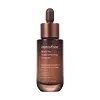What's inside
What's inside
 Key Ingredients
Key Ingredients

 Benefits
Benefits

 Concerns
Concerns

 Ingredients Side-by-side
Ingredients Side-by-side

Water
Skin ConditioningButylene Glycol
HumectantGlycerin
HumectantDipropylene Glycol
HumectantNiacinamide
Smoothing1,2-Hexanediol
Skin ConditioningSqualane
EmollientGlyceryl Polymethacrylate
Cetearyl Alcohol
EmollientAmmonium Acryloyldimethyltaurate/Vp Copolymer
Glyceryl Stearate
EmollientXanthan Gum
EmulsifyingAllantoin
Skin ConditioningHydrogenated Lecithin
EmulsifyingEthylhexylglycerin
Skin ConditioningStearic Acid
CleansingPolyglyceryl-3 Methylglucose Distearate
EmulsifyingAdenosine
Skin ConditioningPalmitic Acid
EmollientParfum
MaskingDisodium EDTA
Sodium Hyaluronate
HumectantLimonene
PerfumingCamellia Sinensis Leaf Extract
AntimicrobialDextrin
AbsorbentTheobroma Cacao Extract
Skin ConditioningLinalool
PerfumingCitronellol
PerfumingMyristic Acid
CleansingPentylene Glycol
Skin ConditioningLauric Acid
CleansingTocopherol
AntioxidantAcrylates/Stearyl Methacrylate Copolymer
Emulsion StabilisingTremella Fuciformis Sporocarp Extract
AntioxidantHyaluronic Acid
HumectantAchillea Millefolium Extract
CleansingCeramide NP
Skin ConditioningWater, Butylene Glycol, Glycerin, Dipropylene Glycol, Niacinamide, 1,2-Hexanediol, Squalane, Glyceryl Polymethacrylate, Cetearyl Alcohol, Ammonium Acryloyldimethyltaurate/Vp Copolymer, Glyceryl Stearate, Xanthan Gum, Allantoin, Hydrogenated Lecithin, Ethylhexylglycerin, Stearic Acid, Polyglyceryl-3 Methylglucose Distearate, Adenosine, Palmitic Acid, Parfum, Disodium EDTA, Sodium Hyaluronate, Limonene, Camellia Sinensis Leaf Extract, Dextrin, Theobroma Cacao Extract, Linalool, Citronellol, Myristic Acid, Pentylene Glycol, Lauric Acid, Tocopherol, Acrylates/Stearyl Methacrylate Copolymer, Tremella Fuciformis Sporocarp Extract, Hyaluronic Acid, Achillea Millefolium Extract, Ceramide NP
Water
Skin ConditioningDipropylene Glycol
HumectantC12-14 Pareth-12
EmulsifyingSodium Citrate
BufferingButylene Glycol
HumectantEthylhexylglycerin
Skin ConditioningCitric Acid
BufferingDisodium EDTA
Houttuynia Cordata Extract
Skin ConditioningLavandula Angustifolia Oil
MaskingCitrus Aurantium Dulcis Peel Oil
MaskingSalvia Hispanica Seed Extract
EmollientCentella Asiatica Extract
CleansingPropanediol
SolventVaccinium Angustifolium Fruit Extract
Skin ProtectingCeramide AP
Skin ConditioningLimonene
PerfumingWater, Dipropylene Glycol, C12-14 Pareth-12, Sodium Citrate, Butylene Glycol, Ethylhexylglycerin, Citric Acid, Disodium EDTA, Houttuynia Cordata Extract, Lavandula Angustifolia Oil, Citrus Aurantium Dulcis Peel Oil, Salvia Hispanica Seed Extract, Centella Asiatica Extract, Propanediol, Vaccinium Angustifolium Fruit Extract, Ceramide AP, Limonene
Ingredients Explained
These ingredients are found in both products.
Ingredients higher up in an ingredient list are typically present in a larger amount.
Butylene Glycol (or BG) is used within cosmetic products for a few different reasons:
Overall, Butylene Glycol is a safe and well-rounded ingredient that works well with other ingredients.
Though this ingredient works well with most skin types, some people with sensitive skin may experience a reaction such as allergic rashes, closed comedones, or itchiness.
Learn more about Butylene GlycolDipropylene Glycol is a synthetically created humectant, stabilizer, and solvent.
This ingredient helps:
Dipropylene glycol is technically an alcohol, but it belongs to the glycol family (often considered part of the ‘good’ alcohols). This means it is hydrating and gentle on skin unlike drying solvent alcohols like denatured alcohol.
As a masking agent, Dipropylene Glycol can be used to cover the smell of other ingredients. However, it does not have a scent.
Studies show Dipropylene Glycol is considered safe to use in skincare.
Learn more about Dipropylene GlycolDisodium EDTA plays a role in making products more stable by aiding other preservatives.
It is a chelating agent, meaning it neutralizes metal ions that may be found in a product.
Disodium EDTA is a salt of edetic acid and is found to be safe in cosmetic ingredients.
Learn more about Disodium EDTAEthylhexylglycerin (we can't pronounce this either) is commonly used as a preservative and skin softener. It is derived from glyceryl.
You might see Ethylhexylglycerin often paired with other preservatives such as phenoxyethanol. Ethylhexylglycerin has been found to increase the effectiveness of these other preservatives.
Limonene is a fragrance that adds scent and taste to a formulation.
It's found in the peel oil of citrus fruits and other plants such as lavender and eucalyptus. The scent of limonene is generally described as "sweet citrus".
Limonene acts as an antioxidant, meaning it helps neutralize free radicals.
When exposed to air, oxidized limonene may sensitize the skin. Because of this, limonene is often avoided by people with sensitive skin.
The term 'fragrance' is not regulated in many countries. In many cases, it is up to the brand to define this term. For instance, many brands choose to label themselves as "fragrance-free" because they are not using synthetic fragrances. However, their products may still contain ingredients such as essential oils that are considered a fragrance.
Learn more about LimoneneWater. It's the most common cosmetic ingredient of all. You'll usually see it at the top of ingredient lists, meaning that it makes up the largest part of the product.
So why is it so popular? Water most often acts as a solvent - this means that it helps dissolve other ingredients into the formulation.
You'll also recognize water as that liquid we all need to stay alive. If you see this, drink a glass of water. Stay hydrated!
Learn more about Water